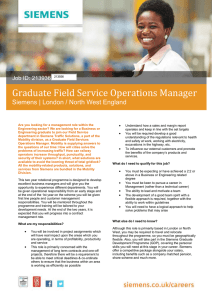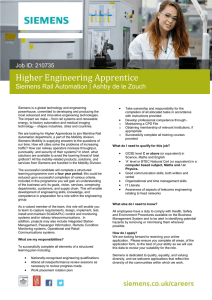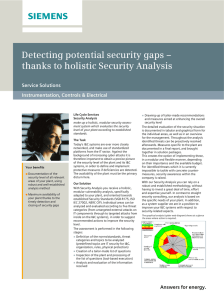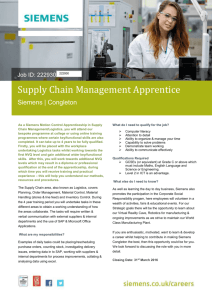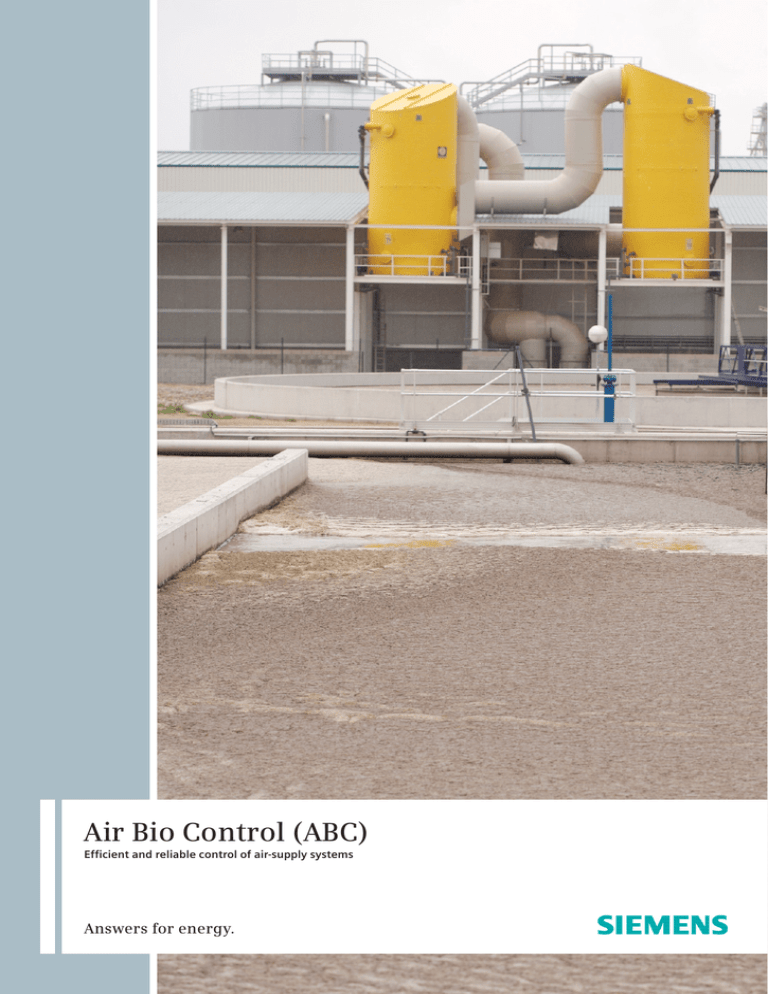
Air Bio Control (ABC)
Efficient and reliable control of air-supply systems
Answers for energy.
Thinking in systems
– the multiplier effect …
Siemens has decades of experience in
turbocompressor technology and aeration know-how,
with more than 6,000 units now in operation worldwide.
Siemens provides complete air-supply
systems for wastewater-treatment plants,
thus ensuring effective integration of the
aeration process with the other downstream processes in the plant. This makes
it possible to achieve full end-to-end control, avoiding bottlenecks and boosting
efficiency at every stage.
The prime advantages of the system
solutions include:
• Single-source responsibility
• System integration
• Greater overall efficiency
• Better control and smoother operation
• Avoiding interface issues
• Start-up and fine tuning
• Greater system reliability
• On-line support via modem
(wireless or PSTN)
Dissolved
oxygen/ammonium/
flowcontrol
Automatic
pressure set-point control
(based on the “most open valve” principle)
Main header
pressure control
The three integrated
control loops
The aeration process
consists of three central
control loops that –
when fully integrated
and fine-tuned – ensure smooth, efficient operation of the
aeration system:
Dissolved oxygen/
ammonium/flow control
Most aeration systems are controlled on
the basis of measurements of the dissolved
oxygen in the aeration tanks. The settings
of the air-flow control valves are based on
these measurements.
It is possible to achieve considerable
additional improvements in control of the
aeration system by also including such
parameters as ammonium control to determine the oxygen set-point. This results in a
lower average air flow and makes it
possible to comply with both current and
future environmental requirements worldwide.
Automatic pressure set point control
To minimize power consumption, the
header pressure is kept as low as possible
by monitoring the control-valve positions.
During peak loads, the header pressure is
increased in order to provide maximum air
flow. Under part-load conditions, it is reduced to keep power consumption to a minimum. This enables continuous adjustment
of the total delivered air flow to match
requirements exactly.
An unlimited range of different processes
can also be linked to the main air header,
thus facilitating control of many additional
sub-processes.
Main-header pressure control
The aeration tanks are supplied with air
flow through a main-air header. This is
kept at a constant pressure by regulating
the compressors between 40–100% capacity.
The right choices
Increasing demands for quality and tougher
legislation on environmental issues
create needs for the best possible control of
the aeration process.
Experience from a large number of
wastewater-treatment plants has shown that
the right choices for control systems and solutions rapidly give full pay-back in terms of
energy savings and ensure full compliance
with legal requirements regarding the effluent.
With the rapidly accelerating automation of
waste water treatment plants, choosing the
most appropriate technology is no longer
sufficient. It is now increasingly important
to identify the overall configuration that
provides maximum efficiency, via integrated
system design.
ABC Panel
The Siemens ABC Panel is designed to ensure the efficient, reliable control and monitoring of the complete air supply system –
automatically and/or remotely, if required. The ABC system uses a
standard Programmable Logic Controller (PLC), running customized, job-specific software, to monitor and control the complete
air-supply system for areation and compressors as one highly
efficient, integrated system. A standardized Profibus DP master
interface is fitted for communicating with multiple Local Control
Panels (LCPs).
Where several aeration cells are automated to provide varying air flow,
flow controllers can be added to control
each air flow control valve with a finetuning sub-loop, enabling set-point
adjustment via the dissolved oxygen
level.
A system that monitors multiple process
variables must be designed and
implemented to ensure reliable, longterm operation.
The most basic solution involves control
of the air-flow control valve directly via
the oxygen levels, using a controller. This
ensures that the biological processes have a
constant level of dissolved oxygen.
Another option is to add a flow controller to
the conventional oxygen-control loop. The
flow controller can also be used to limit the
maximum and minimum air flow.
Cascade control
The graph illustrates the optimized air flow, with
three on-line Siemens compressors. Together,
these provide a seamless, consistent air flow,
ranging from one unit at minimum capacity to all
three compressors at maximum capacity, meeting needs for a wide variety of plant air flows and
wide-ranging system oxygen demands.
The basic oxygen control can
be improved by adding an
ammonium controller. This
increases and decreases the
oxygen set-point when needed, reduces the average air
flow (and energy consumption), and ensures optimum
nitrogen removal.
The ideal air-supply system features full ammonium and
dissolved-oxygen control in order to give precise and stable
operation.
Analysis prior to design
Each wastewater treatment plant operates differently,
with individual characteristics and requirements that
result in widely differing operating cycles.
Prior to any design work, Siemens experts
therefore carefully investigate and analyse
the overall operating philosophy behind
the hourly, weekly and monthly running of
the existing plant and aeration efficiency.
This enables Siemens to provide the
system designs best suited to system
requirements, suchparameters as flowcontrol valve- opening times – all items
that play a crucial role in ensuring minimum downtime and highest efficiency.
Experience in action
When Siemens deals with your air flow
requirements – both current and future
– you benefit from the total sum of our
experience from more than 6,000 singlestage turbocompressors throughout the
world. We know that it is essential to focus
on the correct dimensioning of the aeration system as a whole in order to avoid inefficient operation and unnecessary costs.
Siemens is uniquely capable of designing
aeration systems that exactly match your
present needs, while also taking future
requirements into consideration. We spend
time with your consultants and plant operators to understand your needs in full and
to integrate our know-how with yours in
order to find the most effective form of
control.
The right solution yields considerable
savings up front, as well as greater efficiency in all the other processes that interface with aeration.
Benefits and features
• An automated air-supply system assures
the lowest system-operating pressure,
thereby keeping power consumption to
the minimum.
• Continuous monitoring of process variables such as dissolved oxygen, ammonium ensures the lowest air flow delivery, optimizing the aeration process and
minimizing power consumption.
Precise, continuous air-flow control
makes it possible to enables maximization of the more complex nitrification/
denitrification process, as required in
the most modern aeration processes.
• Air-supply system automation eliminates the need for direct operator intervention and optimizes process control,
ensuring superior effluent quality.
Published by and copyright 2009:
Siemens AG
Energy Sector
Freyeslebenstrasse 1
91058 Erlangen, Germany
Siemens AG
Energy Sector
Oil & Gas Division
Wolfgang-Reuter-Platz
47053 Duisburg, Germany
Siemens Energy Inc.
10730 Telge Road
Houston, Texas 77095, USA
Siemens A/S
Turbomachinery Solutions
Allegade 4
3000 Helsingør, Denmark
Phone +45 49 21 14 00
tomer
t
er.
Phone: +49 180 524 70 00
Fax:
+49 180 524 24 71
(Charges depending on provider)
E-mail: support.energy@siemens.com
Oil & Gas Division
Order No. E50001-G420-A115-X-4A00
Printed in Germany
Dispo 34806, c4bs No. 7423 WS 07092.
Printed on elementary chlorine-free
bleached paper.
All rights reserved.
Trademarks mentioned in this document
are the property of Siemens AG, its affiliates,
or their respective owners.
Subject to change without prior notice.
The information in this document contains
general descriptions of the technical options
available, which may not apply in all cases.
The required technical options should therefore
be specified in the contract.
www.siemens.com/energy/aeration






